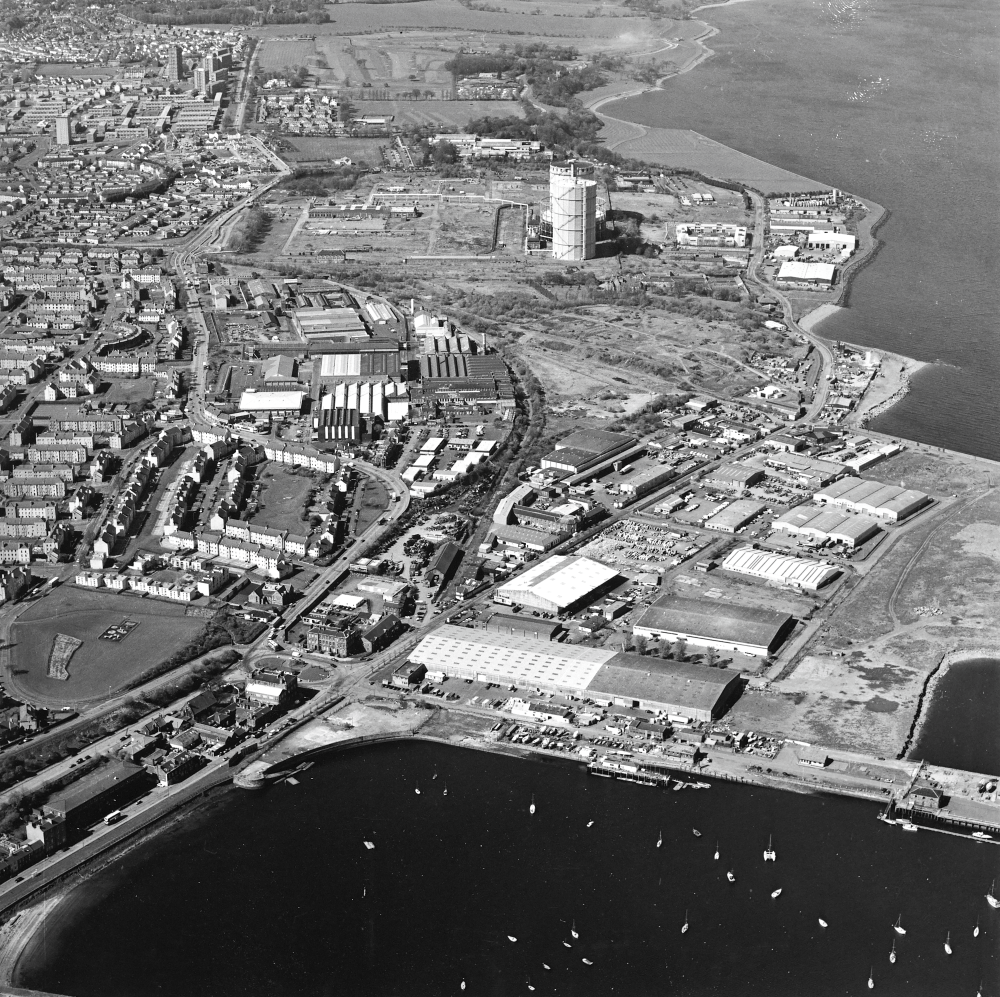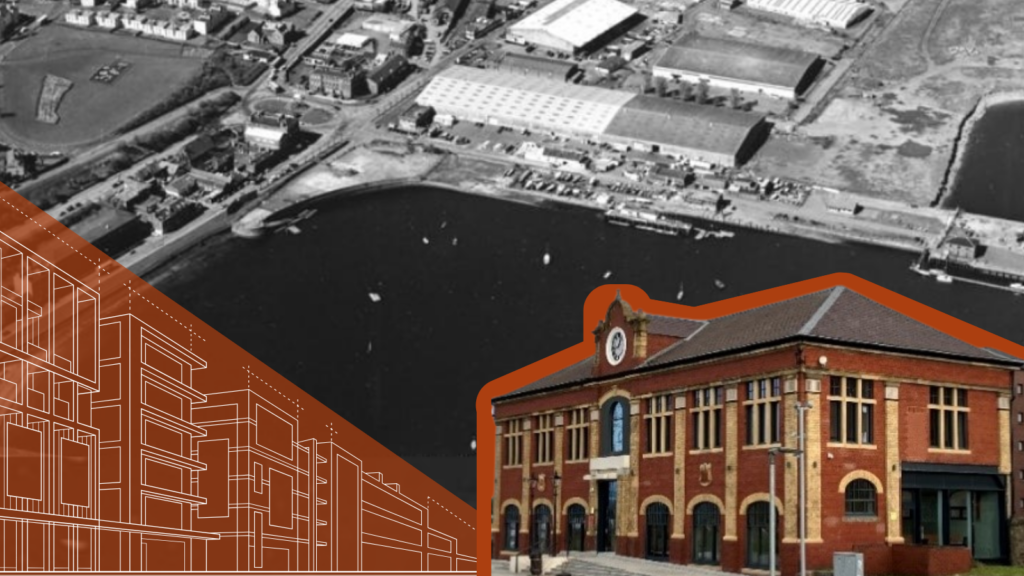On the Waterfront
Imagine a grand castle towering over a largely empty piece of land right beside the Firth of Forth: the odd animal grazes, the sparse building casts a shadow over vacant ground.
This may be what Granton looked like until the early 19th century, when it emerged as a key industrial hub due to its proximity to the Port of Leith. Its growth was driven by the establishment of Granton Harbour in the 1830s. Later followed by the development of gasworks, shipyards, and other industrial facilities.
Granton’s industrial prominence eventually waned. By the mid-20th century, the area’s shipyards and gasworks declined. This led to the closure of many facilities, further marked by the 1960s closure of the Granton railway line.
But today, Granton has been granted a new lease of life.
Reinforcing existing community initiatives while welcoming visitors, the area is being transformed into a vibrant mixed-use waterfront community!

Aerial view of Granton Waterfront (© Crown Copyright: HES, licensed via Trove)
A transformation for the modern era
The Granton Waterfront Redevelopment Programme is a large-scale urban regeneration project, led by Edinburgh City Council. This 1.3 billion pound programme focuses on revitalising the waterfront whilst preserving its industrial heritage.
A key element of the redevelopment includes the restoration and adaptive reuse of historic buildings in the area. It includes the creation of new housing, office spaces, recreational areas, and integrated green spaces, improving connectivity and promoting sustainability.
So, what might some of these proposals include? Let’s take a look.
Granton Gas Holder 1
The Granton Gas Holder 1 dates back to the late 19th century. It was built to supply gas for lighting and heating throughout surrounding areas, including Edinburgh itself. Its cylindrical design was characteristic of structures at the time whose function was to store gas produced at the nearby gasworks.
The gasworks stopped operating in the 1970s following the decline of gas production in the area and fell into disrepair.
Today, the gas holder has category B listed status and forms an integral part of the regeneration project. The structure has been restored and transformed into a community space, including play areas and spaces to walk, sit, and relax.
With the cutting of a ribbon, the park was officially opened in April 2025. One of the opening ceremony activities even included a choral ode to the gasholder’s industrial past and green future.
Gas Holder 1 within the newly established park (Mirra Kannan, 2025)
Granton Castle Walled Garden
The Granton Castle Walled Garden is part of the former Granton Castle estate, established in the early 19th century. The estate and its gardens were developed by Sir John Hope, 4th Earl of Hopetoun, as part of a larger plan to create a grand country residence. The walled garden was used to produce fruit, vegetables, and flowers, creating a self-sufficient estate during the Victorian and Edwardian eras.
Over time, the estate and its gardens fell into disuse, particularly after the castle was demolished in the mid-20th century and the surrounding land was sold off for development.
Yet the walled garden still remains one of the few surviving elements of the original estate.
Granton Castle Walled Garden (Mirra Kannan, 2025)
It still holds tangible clues to its past – just ask any of the volunteers from Friends of Granton Castle and Walled Garden, a community initiative supported by Edinburgh Council. The volunteers have taken the walled garden under lease and use the space to carry out activities with the local community.
Work to restore the wall and doocot commenced in 2022, with a free stone masonry workshop organised by Edinburgh Council in partnership with Friends of the Walled Garden and Scottish Crown Estate marine asset funding. This aimed to introduce people of all ages to stone masonry.
Granton Station
Granton’s former railway station and office block for the gasworks was constructed by W R Herring between 1898–1904. It was designed in a plain Edwardian classical style featuring typical elements such as a waiting room, offices, and even a railway platform which adjoins the building on its South elevation.
The category B listed station operated until 1942, when it was closed as alternative transport links to the area improved. It soon fell into disrepair and was left vacant for many years before it was bought by Edinburgh Council in 2018.
The redevelopment of the station aimed to enhance its historical features whilst integrating it into the wider regeneration efforts. Led by ADP Architecture, it was completed in March 2023.
The building is currently being used by Workshop and Artists Studio Provision Scotland, providing affordable studio space for artists and creatives. The newly created public square in front of the building hosts events and community activities throughout the year.
The restored Granton Station (Jessica Malone, 2024)
Granton Lighthouse Depot
Granton Lighthouse depot was built in the late 19th century as part of the ‘Northern Lighthouse Stores and Buoy Yard’ for the Northern Lighthouse Board. Supplies for lighthouses were stored and transported across Scotland.
The lantern on top of the building was never used for navigational purposes. It served as a space for training and testing lights before they were put into service.
No longer used for its original purpose, the category C listed lighthouse is currently used by local businesses and serves as a local landmark.
If you’ve got an interest in lighthouses, you might be in luck. Under the redevelopment programme, there are plans to restore the lighthouse and adapt it for new uses that could open the building to the public.
Front elevation of Granton Lighthouse (Mirra Kannan, 2025)
Madelvic House and Factory
Madelvic House was built in the late 19th century as the headquarters of the Madelvic Engineering Company. Established in 1895, Madelvic was one of the earliest manufacturers of electric vehicles in the UK, specialising in electric cars.
The company stopped operations in 1901 due to financial difficulties. The building has since served various other uses over time, including as a warehouse and office space.
As an important piece of Granton’s industrial history, it is recognised by a category B listing.
The former office is currently occupied by the Granton Hub, a volunteer-run organisation that aims to elevate the area’s profile, providing a focus for its diverse and evolving communities.
The former production block is currently in a state of ruin, though not for long. The Regeneration Project will see it undergo a major restoration. Proposals submitted by the Lar Housing Trust suggest its conversion into 28 townhouses, while preservating its original industrial features.
Madelvic House Factory (Mirra Kannan, 2025)
A revitalised future
Only a stone’s throw away from Edinburgh’s city centre, Granton Waterfront has been given a fresh start.
Granton is a strong example of a place where a fragmented heritage has come together with new infrastructure. It proposes an exciting future while preserving the past.
Energised by creative community enterprises and greener economies, Granton and its waterfront can be celebrated as a thriving neighbourhood.
Granton Waterfront is not the only site of historical importance in Scotland facing the existential question of, how can we create a new revitalised future, without losing an important part of the past?
But if Granton’s regeneration project has taught us anything, it’s that it can be done.
Want to find out more?
From stories from Stanley Mills, to the Innocent Railway, you can find a range of blogs on Scotland’s industrial history on our website.

